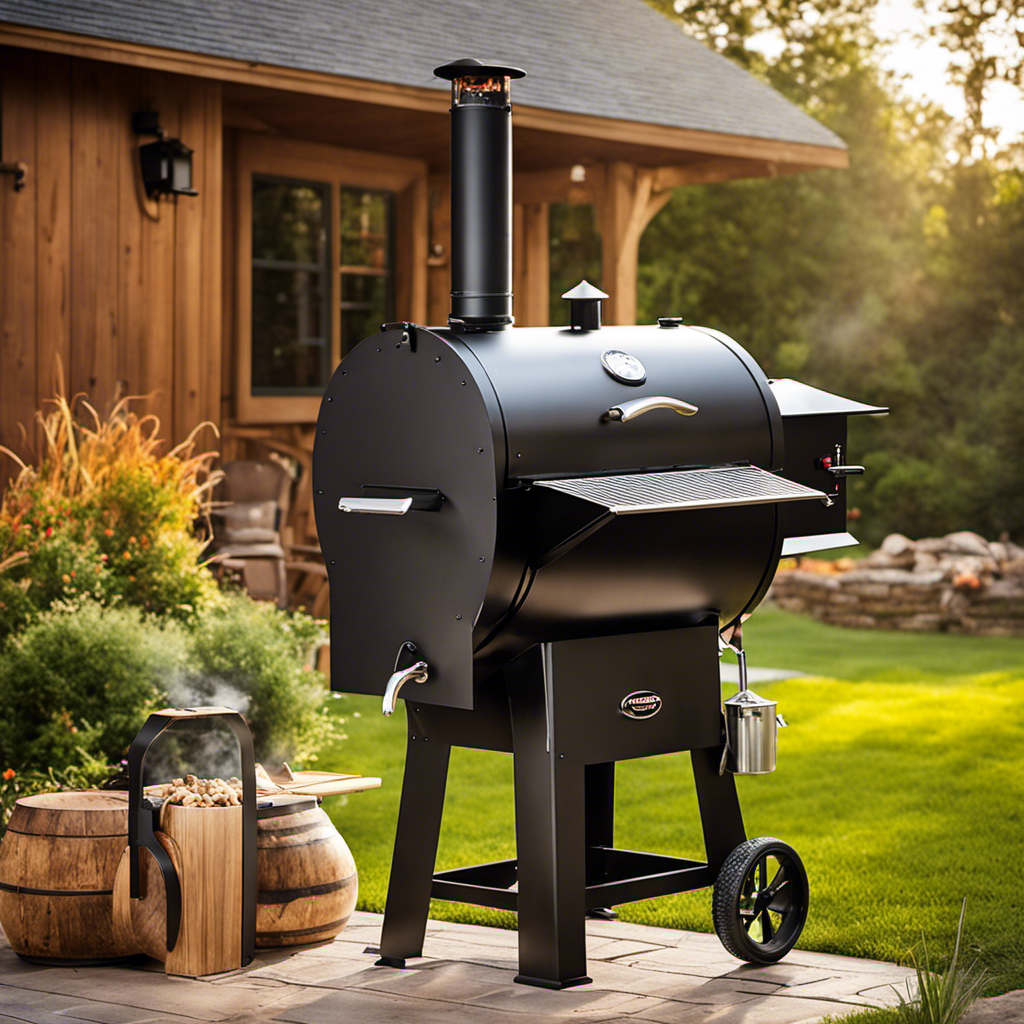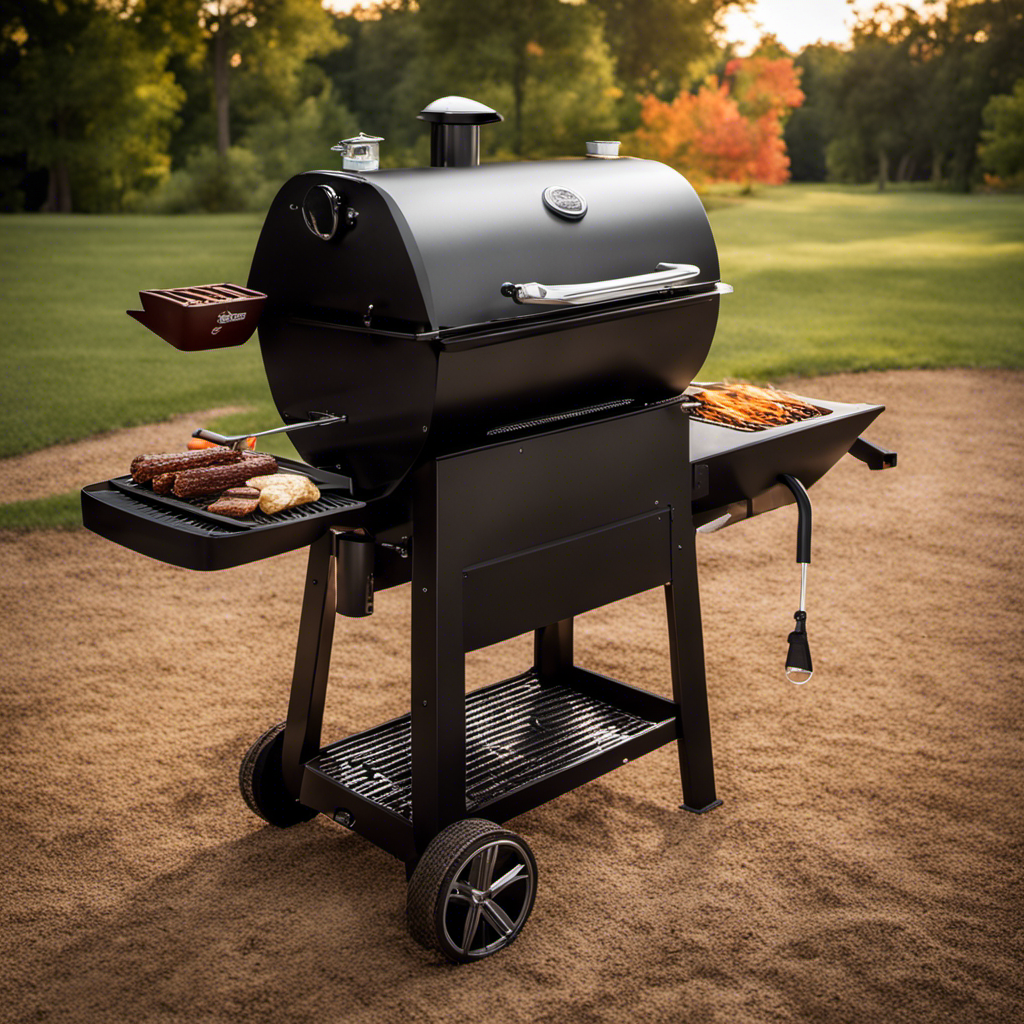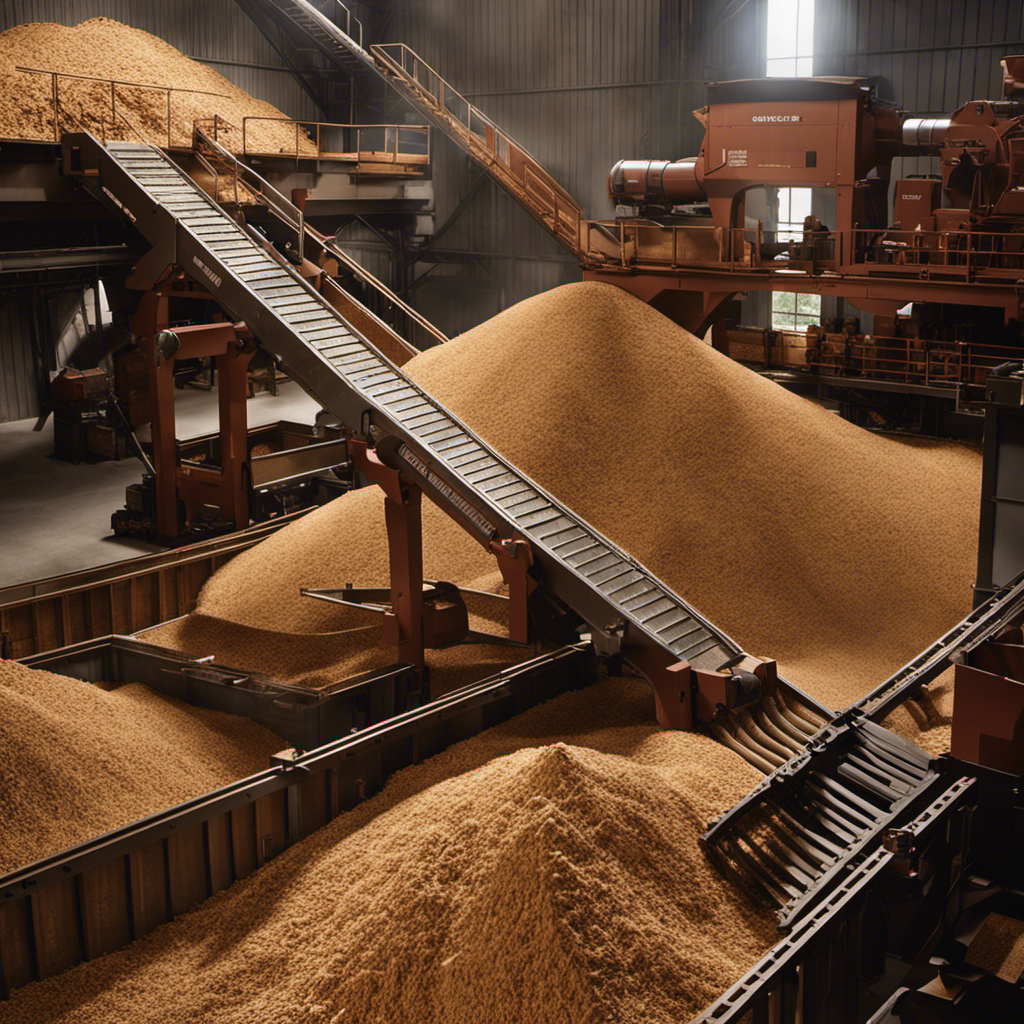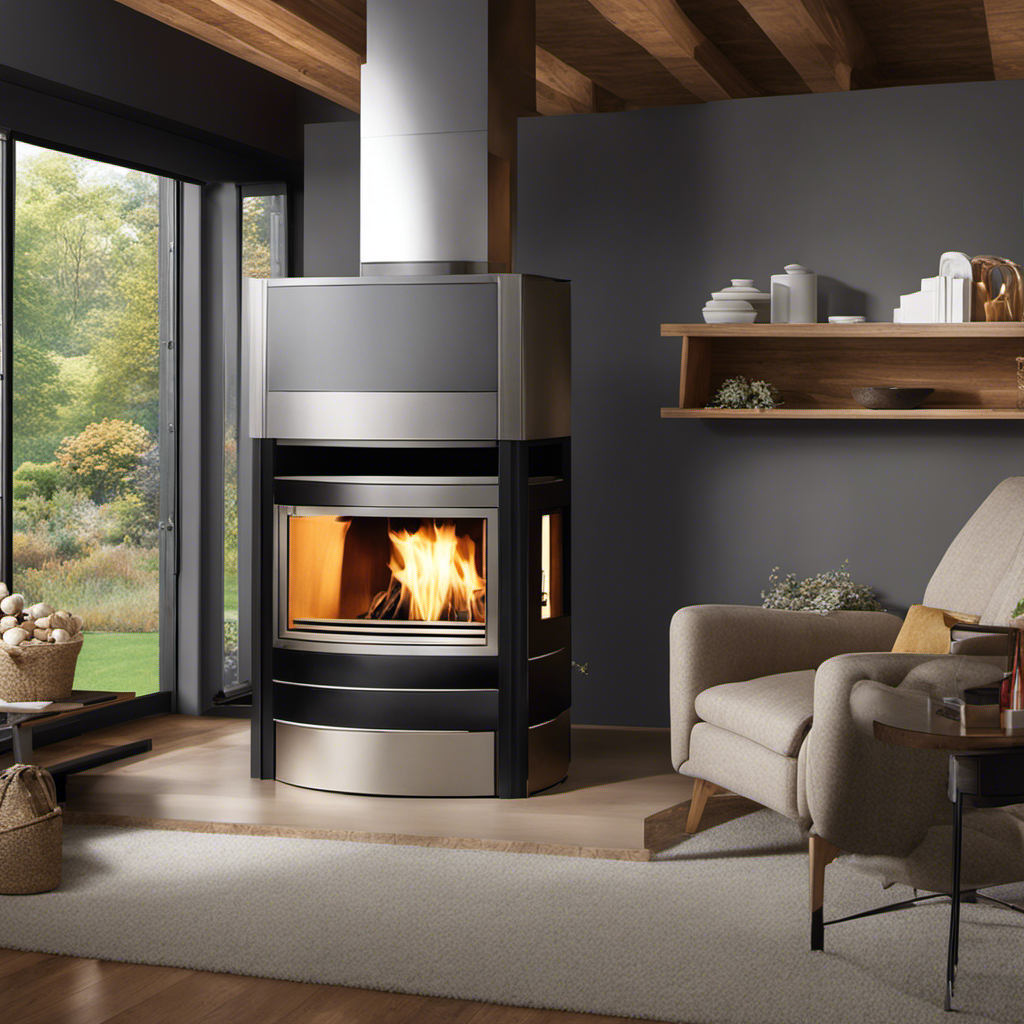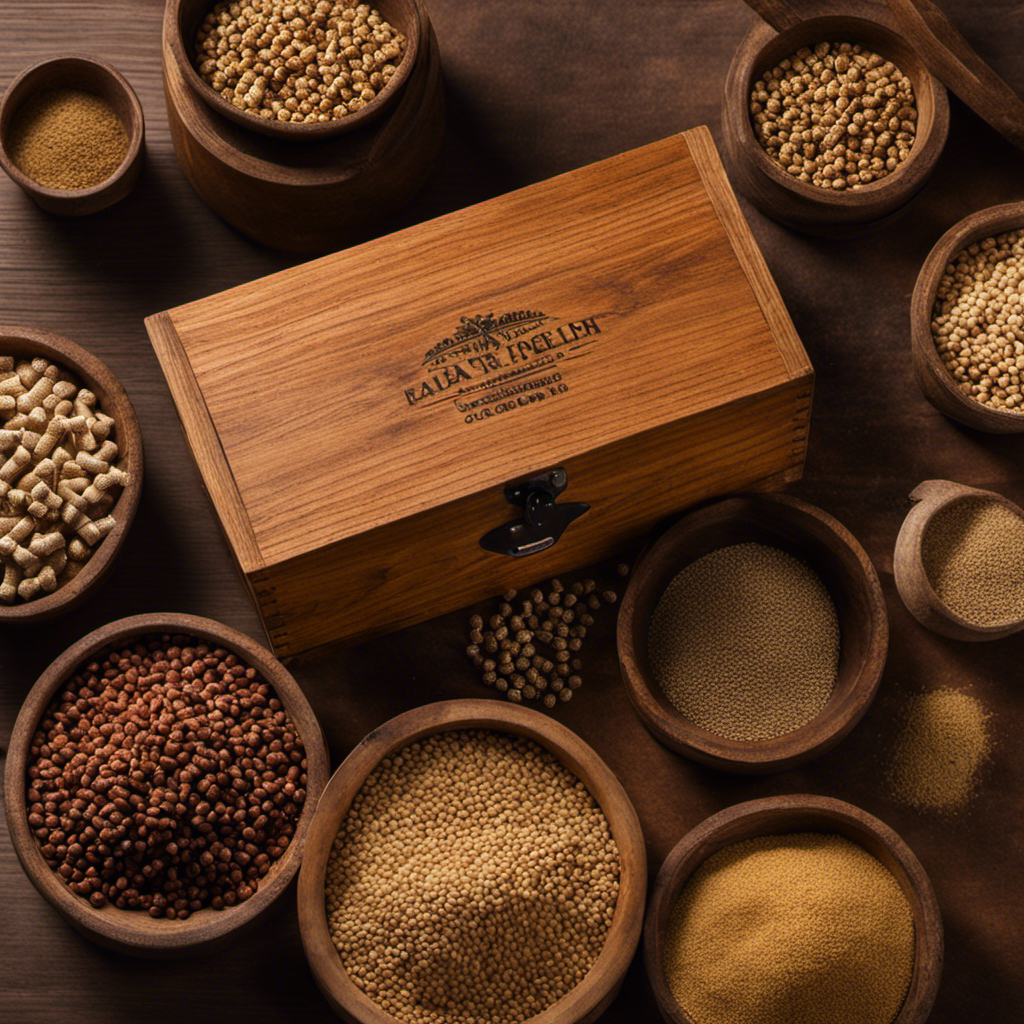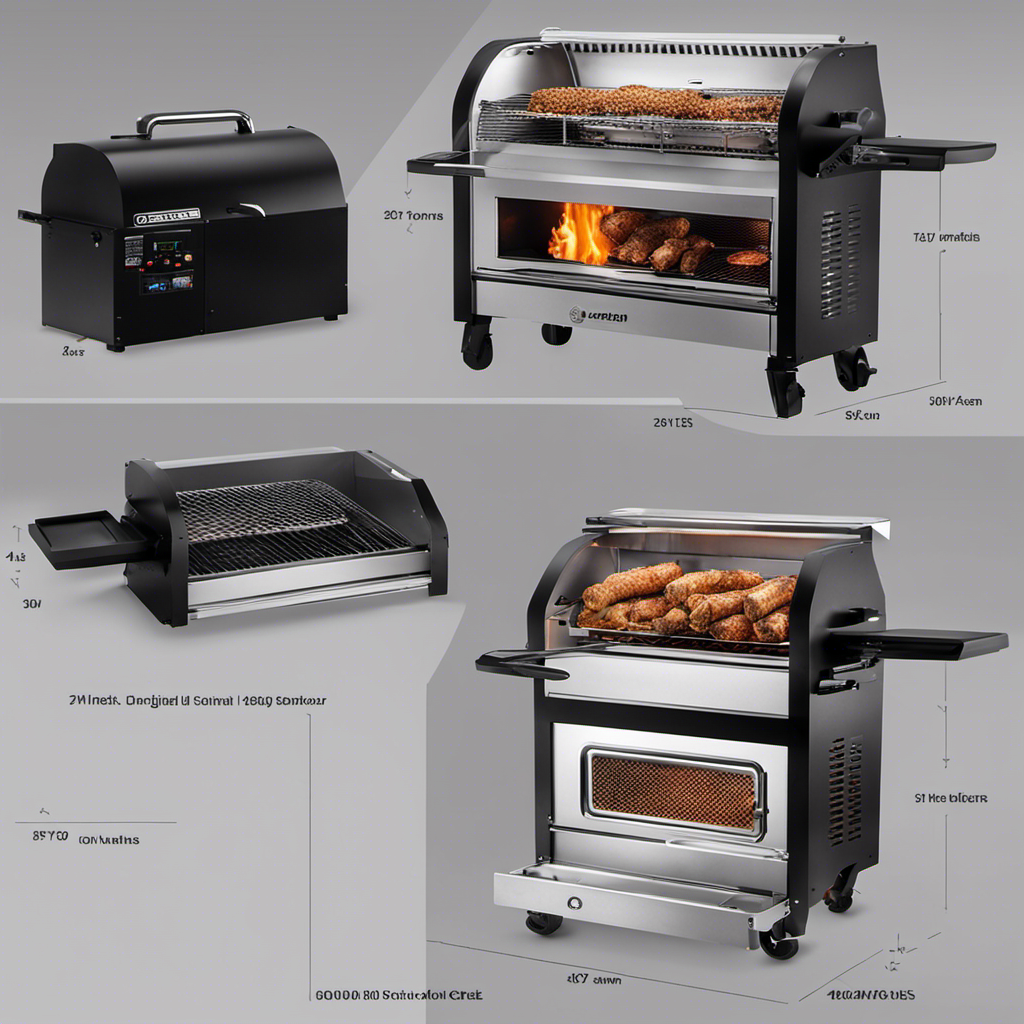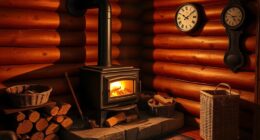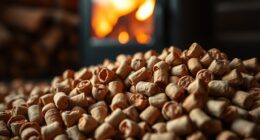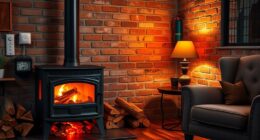Hello, fellow barbecue enthusiasts!
Have you ever fired up your wood pellet smoker, excited for that mouthwatering smoky flavor, only to be left disappointed by a lack of smoke? Well, fear not!
In this article, I’ll be sharing my tried-and-true tips on how to maintain that perfect smoke in your wood pellet smoker. From selecting the right wood pellets to keeping an eye on smoke levels, I’ll guide you through the process step by step.
Get ready to elevate your grilling game and impress your guests with the ultimate smoky flavor. Let’s dive in!
Key Takeaways
- Proper storage of wood pellets in a dry and well-ventilated area is crucial to maintain their quality and prevent moisture absorption and degradation.
- Different wood types impart distinct flavors, so choose the right wood pellets based on the desired taste profile.
- Flavored pellets or wood chips can be used to enhance the smoky flavor of the food.
- Proper preparation, including following the manufacturer’s instructions, checking vents for airflow, and controlling temperature, is important for optimal smoke production.
Understanding the Basics of Wood Pellet Smokers
Understanding the basics of wood pellet smokers is essential for maintaining smoke in them. When it comes to these smokers, one of the most important factors to consider is the fuel source. Wood pellets are the preferred choice for their consistent burn and clean smoke.
However, not all wood pellets are created equal. It is crucial to understand the quality of the wood pellets you are using. Look for pellets made from 100% hardwood with no additives or fillers.
Additionally, proper storage of wood pellets is crucial for maintaining their quality. Keep them in a dry and well-ventilated area to prevent moisture absorption and degradation.
Choosing the Right Wood Pellets for Maximum Smoke Flavor
When it comes to maximizing smoke flavor in a wood pellet smoker, choosing the right pellet types is crucial. Different wood types impart distinct flavors, so it’s important to consider the desired taste profile and pair it with the appropriate pellets.
Additionally, enhancing flavor with pellets can be achieved by using flavored pellets or adding wood chips for an extra smoky kick.
Pellet Types for Smoke
To get the best smoke flavor, you’ll want to use different types of pellets in your wood pellet smoker. The type of wood you choose can significantly impact the taste of your food, so it’s essential to understand the different options available.
Here are three types of wood pellets that can enhance the flavor of your smoked dishes:
-
Mesquite: Mesquite pellets provide a strong and robust smoky flavor, perfect for red meats like beef or lamb.
-
Apple: Apple pellets offer a milder, fruity smoke flavor that pairs well with poultry, pork, and seafood.
-
Hickory: Hickory pellets give a rich, bacon-like flavor, making them ideal for pork, ribs, and other pork-based dishes.
By diversifying the wood types you use, you can create a variety of unique flavors for your smoked foods.
Now, let’s dive into how to enhance flavor with pellets without missing a beat.
Enhancing Flavor With Pellets
If you want to enhance the flavor of your smoked dishes, try experimenting with different types of wood pellets. The type of wood pellets you choose can have a significant impact on the taste and aroma of your food.
Some pellets, like mesquite or hickory, are known for their strong and bold flavors, while others, like apple or cherry, offer a sweeter and milder taste.
You can also find smoke intensifiers, such as wood chips or chunks, which can further enhance the smoky flavor of your dishes.
To infuse maximum flavor into your food, consider using flavor infusion techniques like brining or marinating your meat before smoking. These techniques help the flavors penetrate the meat, resulting in a more flavorful and delicious end product.
Now that you have chosen the perfect wood pellets, let’s move on to preparing the smoker for smoking.
Preparing the Smoker for Smoking
Before you start smoking, make sure the smoker is properly prepared. Pre smoke preparation is crucial to ensure optimal smoke production and a delicious end result.
To begin, set up your smoker according to the manufacturer’s instructions. This may involve assembling the smoker, filling the hopper with wood pellets, and preheating the unit. It’s important to choose the right wood pellets for the flavor you desire.
Once the smoker is set up, check that the vents are open to allow for proper airflow. This will help control the temperature and maintain consistent smoke production.
Now that the smoker is prepared, you can move on to controlling temperature for optimal smoke production. By adjusting the temperature settings and monitoring the smoke levels, you can achieve the perfect balance of heat and flavor.
Controlling Temperature for Optimal Smoke Production
When it comes to controlling temperature for optimal smoke production in a wood pellet smoker, there are three key points to consider:
-
Airflow and smoke balance: Proper airflow and smoke balance are crucial for maintaining a steady flow of smoke and ensuring even heat distribution. This can be achieved by adjusting the vents and ensuring that the smoker is properly sealed.
-
Fuel choice and quantity: Choosing the right type and amount of fuel is essential for achieving the desired smoke flavor and maintaining consistent temperatures. Different types of wood pellets can produce different flavors, so it’s important to choose pellets that complement the type of meat being smoked. Additionally, using the right amount of fuel will help maintain a steady temperature throughout the smoking process.
-
Temperature control techniques: Mastering temperature control techniques will allow for precise control over the smoking process. This can be done by adjusting the vent settings to regulate airflow, as well as using a thermometer to monitor the internal temperature of the smoker. Making small adjustments to these settings can help maintain the desired temperature for optimal smoke production.
Airflow and Smoke Balance
One way to achieve optimal airflow and smoke balance in a wood pellet smoker is by adjusting the dampers. By managing the airflow effectively, you can control the temperature and smoke production, resulting in delicious, smoky flavors.
Here are three key factors to consider when it comes to airflow management:
-
Damper Position: Adjusting the dampers allows you to regulate the amount of oxygen that enters the smoker. Opening the dampers wide increases airflow, leading to higher temperatures and stronger smoke production. On the other hand, closing the dampers restricts airflow, resulting in lower temperatures and milder smoke.
-
Ventilation: Ensure that your smoker has proper ventilation to allow for the smooth flow of air. This helps prevent the buildup of stale or stagnant smoke, resulting in a more consistent and balanced smoke throughout the cooking process.
-
Smoke Ring Formation: Proper airflow plays a crucial role in the formation of a smoke ring on your meat. A well-balanced airflow allows the smoke to circulate evenly around the food, promoting the development of a desirable smoke ring.
Now, let’s move on to the next aspect of maintaining smoke in a wood pellet smoker: fuel choice and quantity.
Fuel Choice and Quantity
To achieve optimal results, you’ll want to consider the type and amount of fuel you use in your wood pellet smoker. The fuel you choose not only affects the flavor of the smoke but also the overall performance of your smoker.
When it comes to fuel storage, it’s essential to keep your wood pellets in a dry and cool place. Moisture can affect the quality of the pellets and hinder proper smoke generation.
Additionally, the quantity of fuel you use is crucial. Too little fuel may not generate enough smoke, while too much fuel can result in excessive smoke and potentially overpower the flavor of your food. Finding the right balance is key.
Now, let’s dive into temperature control techniques to ensure your meat is cooked to perfection.
Temperature Control Techniques
If you want to achieve perfectly cooked meat, you’ll need to master temperature control techniques. A wood pellet smoker gives you the ability to infuse your meat with a delicious smoke flavor. Understanding how to adjust the temperature and smoke intensity is crucial in achieving the desired results.
Different types of wood pellets produce distinct smoke flavor profiles, so it’s important to choose the right one for your taste preferences. To control the smoke intensity, you can adjust the airflow vents and the amount of pellets used. Opening the vents allows more oxygen into the smoker, creating a hotter fire and more smoke. On the other hand, closing the vents reduces the airflow, resulting in a milder smoke flavor.
Now, let’s explore how to add smoke enhancers for extra flavor.
Adding Smoke Enhancers for Extra Flavor
Try using wood chips soaked in water for at least 30 minutes before adding them to the smoker to enhance the smoky flavor of your food. This is just one of the many smoke enhancer alternatives you can experiment with to elevate your smoking experience.
Here are three options that will surely tantalize your taste buds:
-
Fruit Woods: Apple, cherry, and peach woods impart a sweet and fruity aroma to your meats, adding a delightful twist to traditional smoke flavors.
-
Herb Infusions: Infusing your wood chips with herbs like rosemary, thyme, or sage can create a unique and aromatic smoke that pairs exceptionally well with poultry or fish.
-
Whiskey Barrel Chips: These chips, made from aged whiskey barrels, add a rich, smoky flavor with subtle hints of whiskey, perfect for beef or pork.
By exploring these smoke enhancer alternatives, you can experiment with different smoke flavors and create mouthwatering dishes that will impress your friends and family.
Now, let’s dive into the next section on monitoring smoke levels during the smoking process.
Monitoring Smoke Levels During the Smoking Process
Keep an eye on the color and density of the smoke coming out of your smoker to ensure that the levels are consistent and not too thick. Measuring smoke density is crucial for achieving the perfect balance of flavor in your smoked dishes. The density of the smoke should be visible but not overpowering.
Adjusting smoke levels is a skill that comes with experience, but there are a few general guidelines to follow. If the smoke is too thin and barely visible, you may need to add more wood pellets or adjust the airflow to increase combustion. On the other hand, if the smoke is thick and billowing, you might need to reduce the amount of wood pellets or adjust the airflow to decrease combustion.
Monitoring and adjusting smoke levels will help you maintain consistent and delicious results.
Now, let’s move on to cleaning and maintaining the smoker for consistent smoke output.
Cleaning and Maintaining the Smoker for Consistent Smoke Output
To ensure consistent smoke output, it’s important to regularly clean and maintain your smoker. Proper cleaning techniques will help prevent smoke leaks and ensure optimal performance.
Start by removing any ashes from the firebox and cleaning the grates. Use a wire brush to scrape off any built-up residue.
Next, inspect the gaskets and seals for any signs of wear or damage. Replace them if necessary to prevent smoke from escaping.
Additionally, clean the chimney and exhaust vents to ensure proper airflow. Regularly check and clean the hopper to prevent any blockages.
By following these cleaning techniques and preventing smoke leaks, you can maintain your smoker’s efficiency and achieve consistent smoke output.
Now, let’s move on to troubleshooting common smoke issues in wood pellet smokers.
Troubleshooting Common Smoke Issues in Wood Pellet Smokers
If you’re experiencing issues with consistent smoke output in your wood pellet smoker, troubleshooting common problems can help resolve the issue.
When it comes to troubleshooting smoke issues, there are a few key steps you can take to maximize smoke production.
First, ensure that your smoker is properly cleaned and maintained, as a buildup of grease and ash can hinder smoke production.
Next, check the quality of your wood pellets. Using high-quality pellets that are meant for smoking can greatly improve the amount of smoke produced.
Additionally, make sure that your smoker is properly ventilated and that the air intake and exhaust are not blocked.
Finally, consider adjusting the temperature and smoke settings on your smoker to find the sweet spot for producing the desired amount of smoke.
Frequently Asked Questions
Can I Use Regular Charcoal or Wood Chips in a Wood Pellet Smoker Instead of Wood Pellets?
Yes, you can use regular charcoal or wood chips in a wood pellet smoker instead of wood pellets. However, it’s important to note that using alternative fuel sources may affect the flavor and smoke production.
How Long Does It Take for the Smoker to Produce Smoke After It Is Turned On?
When it comes to smoke production time in a wood pellet smoker, it can vary depending on various factors. Troubleshooting smoke production issues may involve checking the pellet supply, air flow, and temperature settings.
Can I Use Wet Wood Pellets in a Wood Pellet Smoker?
Yes, you can use wet wood pellets in a wood pellet smoker, but it will be difficult to maintain smoke. Wet pellets produce less smoke and may not burn efficiently, resulting in less flavor.
How Often Do I Need to Clean the Smoker to Maintain Consistent Smoke Output?
To maintain consistent smoke output in a wood pellet smoker, it’s important to clean it regularly. I find that cleaning every few uses keeps the smoker functioning properly and ensures optimal smoke production.
What Should I Do if the Smoker Is Producing Too Much Smoke and Creating a Bitter Taste in the Food?
If the smoker is producing too much smoke and giving food a bitter taste, I would troubleshoot smoke issues by adjusting the air flow. It’s important to find the right balance for perfect smoke flavor.
Conclusion
In conclusion, maintaining smoke in a wood pellet smoker is like conducting a symphony of flavors. By understanding the basics and choosing the right pellets, we can set the stage for maximum smoke flavor.
Preparing the smoker, controlling temperature, and adding smoke enhancers allow us to orchestrate the perfect balance of taste.
Monitoring smoke levels and cleaning the smoker ensure consistent smoke output. And if any issues arise, troubleshooting will keep our smoke production on track.
With these tips, we can create a harmonious smoke-filled masterpiece every time.
Growing up surrounded by the vast beauty of nature, Sierra was always drawn to the call of the wild. While others sought the comfort of the familiar, she ventured out, embracing the unpredictable and finding stories in the heartbeat of nature.
At the epicenter of every remarkable venture lies a dynamic team—a fusion of diverse talents, visions, and passions. The essence of Best Small Wood Stoves is crafted and refined by such a trio: Sierra, Logan, and Terra. Their collective expertise has transformed the platform into a leading authority on small wood stoves, radiating warmth and knowledge in equal measure.

